Department of Monsterology artist PJ Holden
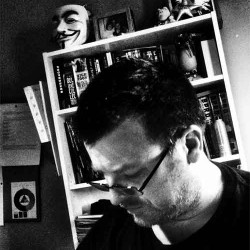
A Chat with Department of Monsterology‘s PJ Holden
When you’re afraid of the dark, you have two choices. First, you can go find the brightest area and see everything you know… but then you’ll never know what you missed. Your second choice is to go forward into the darkness and
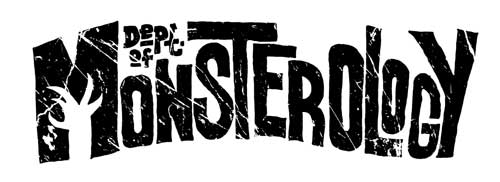
find out what is there. Those who choose the latter pursue the unknown in search for the truth (X-Files) and others for money (Ghostbusters). But what if your investigation has more noble roots, motivated by the joy of pure science or steeped in academia? This is the premise of the robustly illustrated and densely scripted new series Department of Monsterology, from creators Gordon Rennie (writer) and PJ Holden (artist).
The four issue mini series (issue #3 is due out in American stores December 18th) follows several investigative teams from Dunsany College, as they piece together a mystery simply known as “R-Point activity”. As the curious events unfold and personal secrets are revealed, the teams clash with a rival, the Lamont Institute, who seem to be after the same precious artifacts.
I love a good puzzle, and Department of Monsterology promises to be a hearty one!
So what if you’re confronted with a blank, white page? Much like the darkness, you have two options – stay far, far away or delve into it deep, exploring its possibilities with pencil and eraser. It was the second option that Department of Monsterology artist PJ Holden chose for himself many years ago. Here’s my chat with him about his beginnings, some of his early work, and where he sees the comic book industry headed.
Matt: So congrats on a busy 2013! You’ve had a lot going on with Numbercruncher (with writer Si Spurrier from Titan Books) and Department of Monsterology.
PJ: Yeah! Though, as is the nature of all things comics, they’re both books that have had longer gestation periods. Department of Monsterology issue #1 was drawn about two years ago! And Numbercruncher is a reprint of work I did originally a couple of years ago. They just timed themselves to come out [all at once]!
Matt: Yeah, it is funny how the stars align that way. When distribu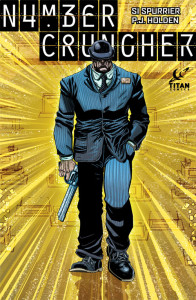 tion companies like Diamond, or whoever, hold the “approval” stamp, you can never know when these things can burst on to the scene!
tion companies like Diamond, or whoever, hold the “approval” stamp, you can never know when these things can burst on to the scene!
But let’s take a trip in the time machine: where does a love of comics fall in the PJ Holden personal timeline? Do you remember your first one?
PJ: My first comic? Blimey, the first ones I remember are British war comics – Warlord, Commando comics (which is still going) and 2000 AD. I literally found some US comics when I was about 7 or 8, mostly Avengers stuff, Jim Starlin era Avengers. [Those were] from about ’74, but I think I found them in about ’77 or ’78.
Matt: Were comics popular with your circle of friends?
PJ: I knew NO ONE who was into comics. Not a soul. It was very depressing.
Matt: Ha-ha! Sadly, that’s a commonplace experience.
PJ: I kind of stopped reading them around the age of 12 when I hit “secondary school” (big change of school, lots of much older kids, and a particularly rough school) and didn’t really go back to comics until about ’88, when John McCrea (yes, that one) and Fred Collier (his school friend) opened a comic shop in Belfast…with people reading comics, and that was when Frank Miller’s Daredevil and Alan Moore’s Watchmen were out and new, and I thought “these are proper big people comics!” I’m not saying that it’s all my fault everything in comics went grim and gritty, but it IS a big coincidence… Now [that] I’m older, I want fun comics.
Matt: Just “finding” comics is a magical moment, because you don’t know where it came from or who made them. But it sounds like going to a proper store really opened your eyes. Was that when you first started learning that comics were created and that there was a craft involved?

PJ Holden’s Judge Dredd sketch
PJ: I think I always had an idea [that] they were created. I remember trying to draw my own comics – even as I’d stopped reading them – around 12 or 13. But I had no idea HOW it was done. I remember, in order to draw one character standing in front of the other, I drew the full characters, and cut them out of a piece of paper, then overlapped them. It didn’t occur to me artists would just draw through or over things. I even had to trim off their legs where they were cut by the panel border.
Matt: You were into decoupage before it was cool!
PJ: I have vague memories of a 2000 AD annual, which had a double page spread (cited by Andy Diggle, Garth Ennis, and many others as their first insight into how comics were made) and that helped a little. I’ve certainly never been into ANYTHING while it’s been cool. At least not knowingly…
Matt: You’re a trendsetter, what can I say! Do you remember the moment when you thought this was something you could try?
PJ: I was always drawing, especially Dredd. My earliest memories of drawing Dredd are probably when I was about 10. But I was drawing comic related stuff even before then. Even in that brief period where I wasn’t reading comics (out of misplaced shame and peer guilt) I was still drawing things. Bits and pieces of arms, legs, or whatever. Though the first time I ever drew what you’d recognize as a comic was probably when I was 18. [Previously] I had drawn my own magazines – with puzzles and pinups when I was about 10 or 11. I used carbon paper to make multiple copies, two copies at a time, and sold them to my cousins.
Matt: When you started in the small press world, whom did you look to for guidance or as an influencer? Did you take your cues from anyone locally?
PJ: I wish I was bright enough to seek guidance! I did hang around John McCrea a lot, and picked up bits and pieces from him. But, by the time I hit the small press, John had moved away from Northern Ireland, and it was back to not knowing anyone into comics (or, at least, no one into comics that wanted to draw).
I sought scripts and just worked on them. I was pretty lucky in that I always managed to find really good writers – Mike Carey and I did something in about 1994, Malachy Coney (who went on later to write for Image Comics in the mid 90s) and Gordon Rennie and I started doing stuff together by the end of the 90s.
Matt: You’ve worked with Gordon Rennie quite a bit! I guess that brings us up to your current project, Department of Monsterology. First, what is it that you like about working with Gordon?
PJ: Well, he can be a right sourpuss, but we’ve known each other a long time. Gordon’s scripts have always been great (actually despite his dour Scottish nature his scripts are always very funny) but the work he’s been doing on Department of Monsterology is really up there with some of my favorite writing by anyone.
We’re both more used to working in the slightly confined spaces of 2000 AD, where six pages would be considered luxurious, so to be able to stretch to 22 pages is just lovely. That said, Gordon doesn’t skimp on the plot, these are not “decompressed” comics by any means!
Matt: Not at all! There are tons of scenes, locations, and characters in each issue. It really demands that you pay attention, in a very good way. Department of Monsterology is such an intriguing concept, one of those “how can this not already exist??” type of things. Which one of the Team members is your favorite to draw at the moment?
PJ: I think the obvious answer is Harry. At least as we’ve seen Harry up until now. He’s a lot of fun in that hulking great big body.
Matt: Yeah, he’s my favorite as well. There’s something so familiar and foreign about him at the same time.
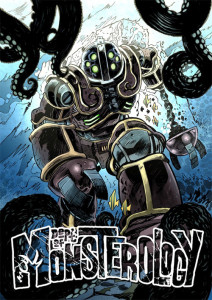
Harry from Dept. of Monsterology
PJ: That said, I’m trying to get the same enjoyment out of drawing the more human characters – it’s easy (a little too easy) to get carried away and put the emphasis on Harry or the monsters, but you need the rest of the cast to make sense of them.
And Gordon writes them all as real people, they all feel distinct, too. I love much of Samwi’s dialogue. She’s so much fun to read. And how [she] and her mentor talk to each other is just lovely.
Matt: Samwi is a firecracker! It is a lot of fun to see her break the academic veneer. On your blog you talk about your habit of having to draw and re-draw. Is that just how the creative process works for you? And has working digitally changed this workflow for you at all?
PJ: Sadly, it’s how I’ve always been. Long deadlines tend to make me lazy, then I draw badly, then I look at it and think “Oh that needs [to be] redrawn”. And then the loop starts again. Though, tight deadlines mean I get to move forward and rarely look back!
There’s not an artist in the world who wouldn’t look at one of their pages and think “ok, if I could redo that page… I’d fix…” – most of them don’t do it, because that’s the act of a madman. Or someone cursed with speed…
Matt: We were joking about it before, but you really have been ahead of your time in many respects, like with Shareware Comics, etc. The digital distribution model continues to change the rules on a nearly a monthly basis. Care to make any predictions on how we’ll be consuming sequential art in the next five years?
PJ: Cor, Shareware Comics – there’s a blast from the past. Essentially, that was “Creative Commons” before there was such a thing!
Matt: I think it is still relevant today! There’s a lot going on in the comic making collectives of today that mirrors those ideas.
PJ: My predictions (I willingly expect to be wrong, so I will try and be brave regardless…)
Apple will buy ComiXology.
ComiXology will then withdraw from non-Apple devices.
Everyone will be furious.
Apple won’t care. (And despite the furore, it won’t make a huge difference to digital comic sales on ComiXology)
Print comics will actually have a decent life. Marvel and DC will continue to sell big, small press stuff aligned with a digital buying marketplace will help push those books in comics shops.
People will move to hardback for pleasure/ownership and digital for reading/paying monthly.
And, finally, I will win £10million on the lotto.
I think, aside from Apple buying ComiXology, and me winning the lotto, most of the above is already a fact rather than a prediction… I’d like to try and read comics on the new Apple Air. I still love print comics, but I ran out of room years ago. I hope DC, Dark Horse and Image all go down the Marvel route of a monthly subscription service.
Matt: So we have Department of Monsterology issues 3 & 4 coming out soon. The collected version of Numbercruncher is out now, correct?
PJ: Department of Monsterology #3 is out on the 18th of December, though my experience with shipping times has not been… predictable. The new hardback of Numbercruncher is in US comic shops last week, and UK comic shops this week and then bookstores more generally at the start of the year, I think.
Matt: Very nice! Any projects up next you want to tease before we go?
PJ: 2000AD Christmas Special out now, I have a 10 page Sinister Dexter Strip in that, and PLEASE GO AND BUY Department of Monsterology because it’s ace and I want to do lots more of it!
Thank you Matt!
Matt: Thanks for your time, PJ! Hope to talk to you again soon!
In addition to interviewing creators and reviewing comics, Matt likes to write comics of his own, including prose short stories and novels. He is based in New York, where he lives with his beautiful wife and (soon-to-be) bouncing baby.
Article/interview is © 2013 Matt Kelly.
Department of Monsterology is TM and © 2013 Gordon Rennie & PJ Holden. All rights reserved.
Numbercruncher is TM and © 2013 Simon Spurrier & PJ Holden. All rights reserved.
Judge Dredd and 2000 A.D. are TM and © 2013 Rebellion Developments Ltd.

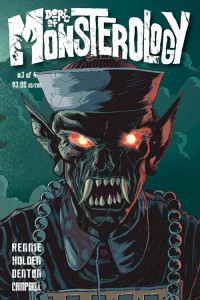
Leave a Reply